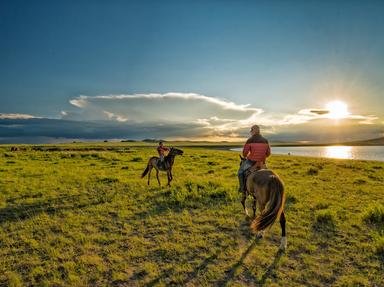Quiz Answer Key and Fun Facts
1. Mongolia is the nineteenth-largest country in the world but it does not have any coastline as it borders only the countries of Russia and China. What term is used to describe a country with borders like Mongolia that could also be used to describe Kazakhstan, Bolivia, and Vatican City?
2. Possibly the most well-known geographic feature of Mongolia is an important desert that lies in the southern part of the country. What is the name of this desert whose name comes from a Mongol word meaning 'desert'?
3. The country of Mongolia has a long border with China, one of the most populous nations on Earth. Which of the following describes the population of Mongolia during the early 21st century?
4. Mongolia has a climate that averages 257 cloudless days a year. Oftentimes this leads to inhospitable winters. What is the Mongolian term for this type of winter that is characterized by mass starvation of livestock from a lack of grazing grounds?
5. On Mongolia's western border lies a mountain massif that contain Mongolia's highest point and five prominent peaks in total. What is the name of this group of mountains that has a name from the Mongolian meaning 'five saints'?
6. Per the 2010 census in Mongolia 53% of the population adhered to a certain religion. Which religion was this that was represented by sites like the Dambadarjaalin Monastery and the Urjinshadduvlin Monastery?
7. The largest city in southern Mongolia is also the capital of Ömnögovi Province. What is the name of this city that is served by a domestic airport with flights to the capital Ulaanbaatar which is located 540 kilometers to the north?
8. A very popular cultural festival is held annually in Mongolia from July 11-13. This celebration is known as Naadam and it showcases Mongolian wrestling, horse racing, and archery. In what city, famous for its National Sports Stadium, is this festival held?
9. The Burkhan Khaldun is a mountain in Mongolia that is believed to be near the birthplace of one of the most famous rulers in human history. What was the name of this ruler who was born with the name Temüjin and who founded the Mongol Empire in 1206?
10. The national symbol of Mongolia was invented in 1686 by a spiritual leader named Zanabazar. This symbol can be found on the flag of Mongolia, its coat of arms, and on numerous government buildings throughout the country. What is the name of this symbol that features the Yin-yang image in its center?
Source: Author
Triviaballer
This quiz was reviewed by FunTrivia editor
Tizzabelle before going online.
Any errors found in FunTrivia content are routinely corrected through our feedback system.


